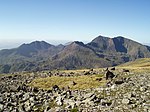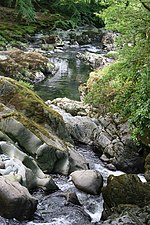Moel Cynghorion
Gwynedd geography stubsHewitts of WalesLlanberisMarilyns of WalesMountains and hills of Gwynedd ... and 2 more
Mountains and hills of SnowdoniaNuttalls

Moel Cynghorion (the Hill of the Councillors) is a mountain in Snowdonia, North Wales. It lies two miles north-west of Snowdon, and forms part of the Moel Eilio Horseshoe walk. The summit is situated on a wide plateau, marked by a pile of stones. The southern slopes are gentle, while the northern aspect is precipitous. The summit has close views of Clogwyn Du'r Arddu and Snowdon (Yr Wyddfa). Views from the summit can extend as far as Holyhead in Anglesey to nearby towns and villages in Gwynedd such as Caernarfon, Llanrug and Llanberis. On a clear day the Wicklow Mountains in Ireland can be seen across the Irish Sea, at a distance of approximately 80 miles.
Excerpt from the Wikipedia article Moel Cynghorion (License: CC BY-SA 3.0, Authors, Images).Moel Cynghorion
Snowdon Ranger Path,
Geographical coordinates (GPS) Address Nearby Places Show on map
Geographical coordinates (GPS)
| Latitude | Longitude |
|---|---|
| N 53.08514 ° | E -4.11265 ° |
Address
Snowdon Ranger Path
Snowdon Ranger Path
LL54 7YS
Wales, United Kingdom
Open on Google Maps











